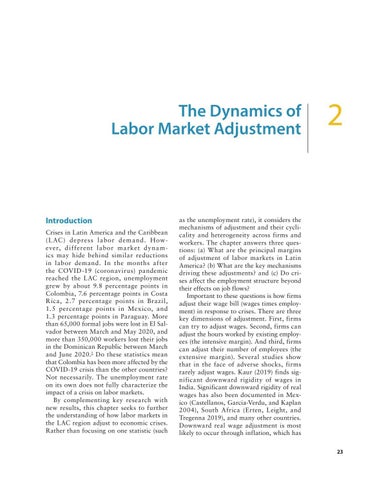The Dynamics of Labor Market Adjustment
Introduction Crises in Latin America and the Caribbean (L AC) depre ss labor dem a nd. However, d i f ferent labor ma rket dy na mics may hide behind similar reductions in labor demand. In the months after the COV ID-19 (coronavirus) pandemic reached the LAC region, unemployment grew by about 9.8 percentage points in Colombia, 7.6 percentage points in Costa Rica, 2.7 percentage points in Brazil, 1.5 percentage points in Mexico, and 1.3 percentage points in Paraguay. More than 65,000 formal jobs were lost in El Salvador between March and May 2020, and more than 350,000 workers lost their jobs in the Dominican Republic between March and June 2020.1 Do these statistics mean that Colombia has been more affected by the COVID-19 crisis than the other countries? Not necessarily. The unemployment rate on its own does not fully characterize the impact of a crisis on labor markets. By complementing key research with new results, this chapter seeks to further the understanding of how labor markets in the LAC region adjust to economic crises. Rather than focusing on one statistic (such
2
as the unemployment rate), it considers the mechanisms of adjustment and their cyclicality and heterogeneity across firms and workers. The chapter answers three questions: (a) What are the principal margins of adjustment of labor markets in Latin America? (b) What are the key mechanisms driving these adjustments? and (c) Do crises affect the employment structure beyond their effects on job flows? Important to these questions is how firms adjust their wage bill (wages times employment) in response to crises. There are three key dimensions of adjustment. First, firms can try to adjust wages. Second, firms can adjust the hours worked by existing employees (the intensive margin). And third, firms can adjust their number of employees (the extensive margin). Several studies show that in the face of adverse shocks, firms rarely adjust wages. Kaur (2019) finds significant downward rigidity of wages in India. Significant downward rigidity of real wages has also been documented in Mexico (Castellanos, Garcia-Verdu, and Kaplan 2004), South Africa (Erten, Leight, and Tregenna 2019), and many other countries. Downward real wage adjustment is most likely to occur through inflation, which has
23

